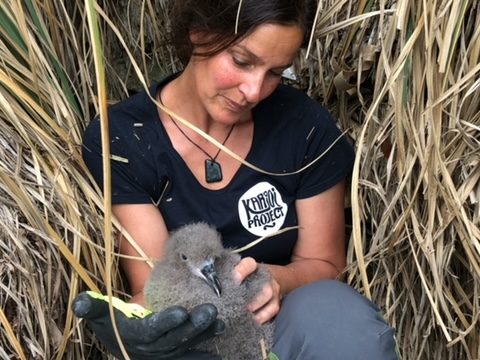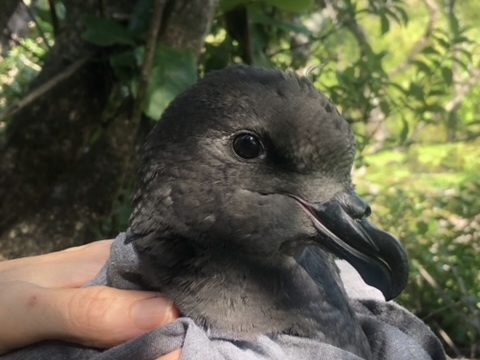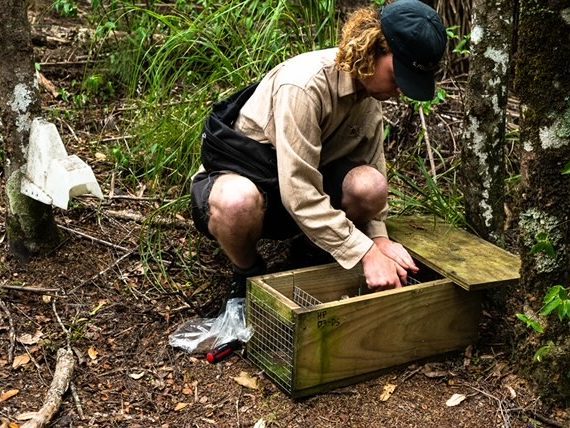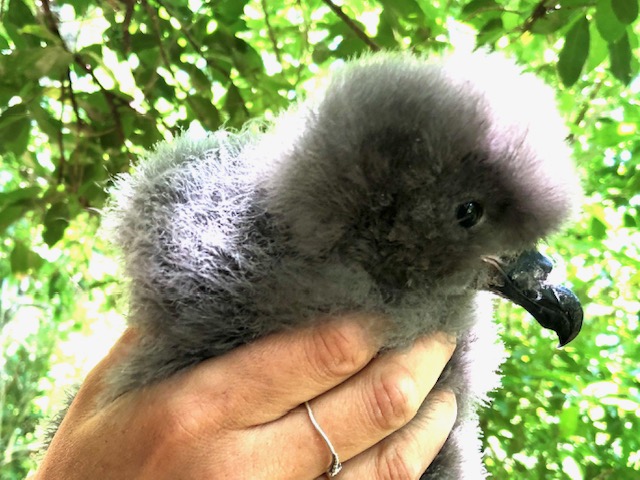Tucked into cliff burrows vulnerable little fluff-balls are living alone, visited once a week by their parents for feeding. These ōi (grey-faced petrel) babies won’t fully fledge until the height of summer, which means many months of living alone – only a claw’s reach from passing stoats and rats.

Luckily for the ōi, they won’t have to make it through this critical time totally alone – there’s some help at hand.
High on the cliffs above the main beach in surf town Raglan (Whāingaroa), beneath the shadow of a strong and beautiful mountain named Karioi, spring has arrived for the resident ōi population in the form of new life: chicks.

Since 2009, Te Whakaoranga O Karioi (The Karioi Project) founder Kristel van Houte has been working with a growing number of staff and volunteers to protect the ōi and the other species living on the slopes of the mountain. They want to restore the maunga to how it once was – “inundated with seabirds.”
“New Zealand was once covered in native vegetation, and now we have about 20% left – there is just a tiny slice of this coastline that still has these birds, and we have the privilege of having them in our backyard, on our doorsteps,” says Kristel.
Starting from humble beginnings
Now deeply embedded into the Raglan community, with hundreds of volunteers, ten paid staff and a network of traps spread across Karioi and beyond, covering thousands of hectares of land, it’s hard to imagine The Karioi Project’s humble beginnings.
“As with many successful community projects, we started out as a handful of keen volunteers who just cared about the maunga and biodiversity,” Kristel says.

“We wanted to see nature thrive again and inspire our community to care for it – when ecosystems flourish, everyone benefits.”
When the team first began recording activity at the ōi burrows, there were less than a handful of nesting birds due to introduced predators.
Today Kristel tells me this number has increased to nearly sixty burrows across three different sites on the Raglan coastline and a small number of kororā (little blue penguins) nesting.
“We first saw signs of the ōi in 2009, but it wasn’t until 2017 that we saw the first chick fledge,” Kristel says.
“We’ve found more active burrows every year as we continue to expand and intensify predator control.”
Indicators of ocean health
During our summer months, the ōi feed far out to sea, off the coast of Aotearoa New Zealand and Australia, before flying home in April and May to breed.

The chicks hatch in August or September, and Kristel and her team are there to support them right the way through until they fledge at around 118 days old and can fly away to feed at sea. They will return five or six years later to find their own mates.
“Seabirds are world travellers… they connect New Zealand to the rest of the world,” Kristel says.
“By studying seabird breeding, they tell us the story of the “health” of the marine environment,” she says.
“Seabirds respond to fluctuating food supply and sea temperatures, and they bring nutrients – in the form of guano – from the sea back to land; they’re an integral part of our ecosystem.”
“Everything that happens at sea will impact those birds and whether they come home again,” she says.
Learning to live with ōi
When they do make it home mating pairs get ready for breeding, scratching away into the hillsides with their sharp claws and beaks and burrowing in, often returning to their natal breeding grounds.
Sometimes this can include unlikely locations. “They’ve made nesting sites under people’s spa pools and kayaks, and once someone found them trying to nest in their garage,” Kristel says.
While there can be tension between human activity and keeping the birds safe, Kristel says the Raglan community is learning to look out for birds by keeping dogs on leads in vulnerable areas and getting involved as volunteers.
There are now more than one hundred and fifty people volunteering for The Karioi Project, trapping on the mountain or in their own neighbourhood, monitoring birds, and learning about the local flora and fauna through the education programmes the Karioi team offers.

“Seabirds are the most threatened bird species in the world and New Zealand has the most endemic species right here… it’s incredibly unique that we have these birds right here in Raglan,” she says.
“Helping people to understand the importance of protecting our local ecosystems is also part of our project, and when people see the increase in life and biodiversity here, they can feel proud because they’re part of making this happen.”
While the conservation gains have been significant, Kristel says the team aims to widen its reach beyond the mountain.
“We want to create ecological corridors and predator free habitats linking Toreparu Wetland, its surrounding streams and the two harbours – Raglan and Kawhia.”
“There is still much work to do, and we’re here for it.”

